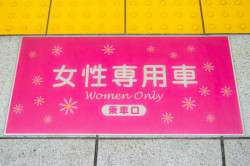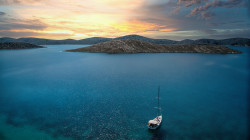
November 7, 2008
Amabiki Village
Escape the ordinary at an outdoor sculpture exhibit in Ibaraki
By Metropolis
Originally published on metropolis.co.jp on November 2008

Photos by Sadamu Saito
All too often, the stuffy, “white box” nature of Tokyo galleries kills any sense of atmosphere and drama invoked by the artwork. Feelings of calm and introspection instead turn to apathy and oppression. So my attention is drawn to Ibaraki, where an exhibition of sculpture and photography is taking place in the small, rural hamlet of Amabiki. A total of 42 artists (mostly sculptors) have come together to free their works from the choking confines of the city and the innumerable, faceless galleries that inhabit it.
The organizers of the seventh Amabiki Village Photography and Sculpture exhibition believe that the environment in which a piece of art is placed is just as important as the artwork itself. Most of the sculptures have been produced on a large scale, and all of them make the most of the untouched countryside in which they are situated.
One piece, “Oracle Under The Trees” by Yusuke Toda, stands an imposing 6m tall, and its carved steel, stone and soil frame weighs a full 4.5 tons. The work draws the viewer’s attention high into the natural canopy supplied by the surrounding trees. Its rusted exterior, as well as looking as organic as everything around it, perfectly complements the slowly changing hue of the autumn leaves, especially as the sap and natural oils secreted by the trees drip onto the sculpture and help to color it.

by Sadamu Saito
Other pieces make the most of white granite cut directly from Mt Kaba, which looms over the village. One such work, “Katamari no Katachi” (lit. “the shape of a clump”) by Jun Yamazoe, is located deep in a copse of long grass cut into a kind of natural atrium, and features an enormous carved granite plinth. Surrounded by green on all sides, with the pure white sculpture in the middle of the clearing and only the expansive sky above as a ceiling, the viewer can enjoy an ambience impossible to match in any standard gallery.
Yet more pieces are located in the now defunct granite quarry overlooking the vast open plains, with freshly harvested rice paddies and a seemingly endless horizon.
One of the exhibition’s lighter moments is supplied by an army of metallic dogs, painted in camouflage to blend in with the flora. Some stand proudly to attention, others are poised rooting through the grasses, and one just squats beside a bush.

by Sadamu Saito
Another sculpture, Masao Shiga’s “Kaze no Iro ‘no Pazuru’” (lit. “a puzzle” of the color of the wind) is located at the site of the former rail platform, which now is sans railway, as apparently Amabiki has been deemed too rural to warrant such modern infractions as regular train service. The sight of rows and rows of thin rods with little white, vinyl teardrop heads—resembling ranks of foot soldiers—might even allow you a little flashback to standing in line and waiting for the rush hour train at Shinjuku station.
Forty-two artists are featured along the 20km route, which can be navigated in a day on one of the bikes available for rent at the exhibition’s Information Center. You can also take in the course by car. Some pieces are in old buildings, some under trees, a couple make use of long abandoned play parks, and others are simply placed in the middle of the rice fields.
It is easy to see why Amabiki was chosen as the location for this truly one-of-a-kind exhibition. The vast plains of rice paddy interspersed by gently flowing irrigation channels. The dense bamboo forests and sporadic trees. The tall grass and the crumbling stone torii. The disused quarry and the slowly decaying wooden buildings. The rusted play parks and natural, slow, organic, country vibe and of course the open sky which is so often sorely missed in Tokyo city. Here it is unmissable, towering overhead, threatening to engulf everything beneath it with its sheer magnitude, running the gamut of colors over the course of a day with the most intense and dramatic cloud forms. The environment and the art work together in perfect harmony to create a majesty and a wonder impossible to recreate in the city. Get there before it closes at the end of the month.
Daytrips to Amabiki Village from Tokyo are easy with a car, via either the Joban Expressway or National Route 50. By train, the quickest route is to take the shinkansen from Tokyo to Oyama station, then the Mito line to Iwase. You can also get to Oyama on the much slower but slightly cheaper JR Tohoku-honsen line from Ueno. From Iwase, hail a cab for the 10min ride to the exhibition’s information center. For more travel tips contact the Sakukragawa Tourism Board (www.city.sakuragawa.lg.jp). The exhibition’s official site (http://members.jcom.home.ne.jp/amabiki) also offers some useful English information.

by Sadamu Saito







